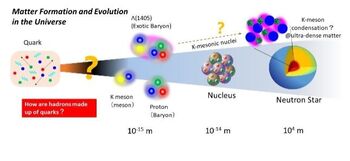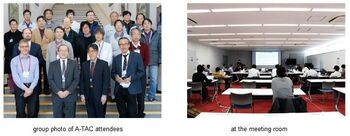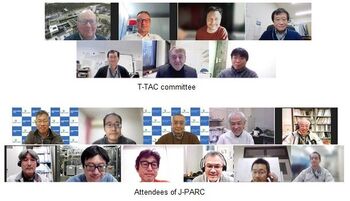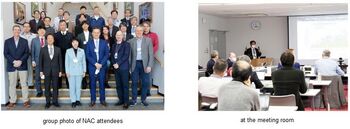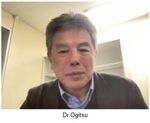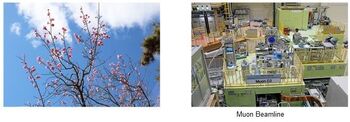J-PARC News March 2023 (Issue #214)
■Measurement of Unusual Baryon Formed by K Mesons and Protons
- Successful Direct Measurement of Mass of Λ(1405) Particle
The Standard Model of particle physics tells us that most particles we observe are made up of combinations of just six types of fundamental entities called quarks. However, there are still many mysteries, one of which is an exotic, but very short-lived, Lambda resonance known as Λ(1405). For a long time, it was thought to be a particular excited state of three quarks—up, down, and strange—and understanding its internal structure may help us learn more about the extremely dense matter that exists in neutron stars.
Now, a research group from Osaka University, KEK, RIKEN, JAEA, Tohoku University, and J-PARC center succeeded in synthesizing Λ(1405) for the first time by combining a K^- meson and a proton and determining its complex mass (mass and width). The K^- meson is a negatively charged particle containing a strange quark and an up antiquark. The much more familiar proton that makes up the matter that we are used to have two up quarks and a down quark. The researchers showed that Λ(1405) is best thought of as a temporary bound state of the K^- meson and the proton, as opposed to a three-quark excited state.
In a study published recently in Physics Letters B, the group describes the experiment they carried out at the J-PARC accelerator. K^- mesons were shot at a deuterium target, each of which had one proton and one neutron. In a successful reaction, a K^- meson kicked out the neutron, and then merged with the proton to produce the desired Λ(1405). “The formation of a bound state of a K^- meson and a proton was only possible because the neutron carried away some of the energy,” says an author of the study, Kentaro Inoue. One of the aspects that had been perplexing scientists about Λ(1405) was its very light overall mass, even though it contains a strange quark, which is nearly 40 times as heavy as an up quark. During the experiment, the team of researchers was able to successfully measure the complex mass of Λ(1405) by observing the behavior of the decay products.
“We expect that progress in this type of research can lead to a more accurate description of ultra-high-density matter that exists in the core of a neutron star.” says Shingo Kawasaki, another study author. This work implies that Λ(1405) is an unusual state consisting of four quarks and one antiquark, making a total of 5 quarks, and does not fit the conventional classification in which particles have either three quarks or one quark and one antiquark. This research may lead to a better understanding of the early formation of the Universe, shortly after the Big Bang, as well as what happens when matter is subject to pressures and densities well beyond what we see under normal conditions.
For more information, please visit the J-PARC website (only in Japanese):https://j-parc.jp/c/press-release/2023/01/26001098.html
For information about a press release on K mesons and bound states of nuclei, please visit (only in Japanese): https://j-parc.jp/ja/topics/2019/press190124.html
■The 17th Tokai Forum - Towards Social Implementation of Research and Development Achievements - February 9
This forum is held annually to have local residents in Tokai Village and surrounding areas understand the activities of the Tokai Area of Japan Atomic Energy Agency (JAEA). This year, the forum was held face-to-face for the first time in four years, and 100 people attended the event at the Tokai Culture Center, which also streamed online.
At the beginning of the forum, Executive Director Oigawa reported on "Growing Expectations for Nuclear Energy and Role of JAEA," and Director of J-PARC Center Kobayashi gave an overview of the accelerators and neutron experiments. Then, Dr. Kamiya, Sub Leader of Accelerator Section Ⅲ, presented a report titled "Development of Energy-Saving and Space-saving Ultra-High Vacuum Pumps Using Vacuum Technology of J-PARC Accelerator.” He reported on using a titanium vacuum vessel as an ultra-high vacuum pump. He also explained the reasons for the application of titanium as an ultra-high vacuum pump, the development of surface modification technology, experimental results demonstrating the maintenance of an ultra-high vacuum, and future developments such as industrial contributions.
For more information, please visit the Nuclear Fuel Cycle Engineering Laboratories website. https://www.jaea.go.jp/04/ztokai/forum/ (Japanese only)
■T2K Collaboration Meeting held (February 6-10, AQBRC)
A T2K collaboration meeting was held at the AYA'S LABORATORY Quantum Beam Research Center (AQBRC) from February 6th to 10th. This was the first on-site meeting in recent three years, and 115 collaborators, including researchers from overseas, participated.
The neutrino beam period is scheduled from April after two years of long shutdown for the Main Ring (MR) upgrade. In near future, the neutrino beam power will exceed 750 kW, which is the first goal when the experiment started in 2009. The upgrade of the near detectors in the J-PARC site is also in progress. These developments were reported and actively discussed at the meeting.
■International Advisory Committee Meeting
The J-PARC center held an International Advisory Committee meeting on February 24-25 to receive international advice on the activities and achievements of the past year. Before that, three International Advisory Committee meetings had been held from January 26 to February 10.
(1) Accelerator Technical Advisory Committee (A-TAC) (January 26-27, at J-PARC and online)
The committee highly evaluated achieving availability of approximately 96% with 730-830 kW beam power at the material and life science experimental facility (MLF) during user operation. The committee also suggested that J-PARC should take measures against reduced beam operation hours due to rising electricity costs.
(2) Transmutation Experimental Facility Technical Advisory Committee (T-TAC) (February 3, online)
The J-PARC reported on the status of the experimental facility planning and the research and development of lead-bismuth target and proton beam technology. The committee encouraged on launching the user community for the experimental facility last year and recommended internationalizing the user community.
(3) Neutron Advisory Committee (NAC) (February 9-10, J-PARC)
J-PARC reported on the current status of MLF and research results. It was the first time in three years that the meeting was held in person. The latest research results and reports on industrial applications, etc. of the neutron source were presented, and the committee evaluated that the operation plan and ongoing technological development of the neutron source were appropriate.
■J-PARC Hello Science "Superconducting Electromagnets Used in Accelerators" (January 27th)
Dr. Toru Ogitsu of the Cryogenics Section introduced how superconducting electromagnets have been used in accelerators, incorporating his career experiences. Although superconductivity was discovered in 1911, it was only with the discovery of the NbTi alloy superconducting material in 1962 that it became practical. In the 1970s, superconducting NMR and medical MRI magnets were commercialized and widely used in the 1980s. On the other hand, superconducting electromagnets have been used in the field of accelerators from an early stage. They have been used in large accelerators worldwide, from full-scale use in the FNAL/Tevatron in 1983 to the CERN/LHC.
Dr. Ogitsu became an assistant at KEK in 1986. From 1990 to 1993, he worked as a visiting researcher at the SSC (Superconducting Super Collider) Laboratory in Texas, analyzing test results of superconducting magnets. After the construction of the SSC was canceled in 1993, he returned to KEK. He worked on developing superconducting electromagnets for the LHC, which converge beams near the collision point, and for the J-PARC accelerator. In particular, he created the world's first combined function superconducting electromagnet using asymmetric coils due to budget and scheduling constraints when constructing the neutrino experiment facility. This led to him receiving the IEEE Applied Superconductivity Award. He also explained plans for superconducting electromagnets and the MLF at various J-PARC facilities.
■Sanpo-michi #32 -Plum Branch and Muon Beamline-
The muon beamline at the MLF is curved like a branch of a plum tree.
Plum trees produce many thin branches to distribute nutrients. In order to concentrate the nutrients on the branches that are expected to produce flowers and fruit, the other branches must be pruned to bend the remaining branches.
Neutrons cannot be bent by magnetic force, and the neutron beamline extends straight from the neutron source to the experimental apparatus, where the sample is placed at MLF. Conversely, Muons are charged with positive or negative electricity and can be easily bent. Since muons produced by a muon target scatter in all directions, a magnetic field is applied to turn the beam in a specific direction to concentrate the muons. This also removes muons with unnecessary energy. This means that the muon beamline is also pruned.
Plum blossoms have begun to bloom on the JAEA site where J-PARC is located. Although the individual flowers are small and inconspicuous, they color the entire plum-grove red and white and fill the surrounding area with their fragrance, reminding us that spring is just around the corner. Muons weigh only one-ninth of a proton. However, muons passing through the twisting beamlines are steadily producing results as giant microscopes for examining the inside of objects, including non-destructive testing of the Ryugyu rocks brought back by HAYABUSA2 and cultural heritage.

